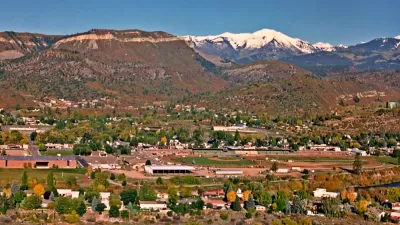Officials in Santa Fe have announced plans to demolish an amphitheater designed by architect Paolo Soleri, the visionary behind the as-yet-unfinished Arcosanti project. David Licata says it deserves to be saved.
In 1968, 45 years after it was completed, Frank Lloyd Wright's Imperial Hotel in Tokyo was demolished in the name of urban development; the façade and pool were saved and relocated to Inuyama, but other than that it exists now only in photographs and a few person's memories.
In the mid-Sixties, a one-time apprentice to Frank Lloyd Wright, Paolo Soleri, an architect who was employing green building practices fifty years before the word "green" means what it does today, was commissioned by the Institute of American Indian Arts to design an amphitheater on its Santa Fe campus. Last week it was officially announced that the amphitheater would be razed by the end of the summer.
The Paolo Soleri Amphitheater is respectfully situated and brilliantly integrated into its landscape; it provides a unique atmosphere to witness any kind of event, from a rock concert to a high school graduation. It looks more like earth art than a theater, a piece of sculpture where the event is part of a larger experience. Its comparison to the Red Rocks Amphitheater is not inappropriate.
The theater is on land that belongs to the Santa Fe Indian School (SFIS), governed by the All Indian Pueblo Council. As a sovereign state, they have the right to demolish any building and cut down any vegetation on their land, and have done so in the past. Their stated reasons are economic and educational. Repairing it and bringing the building up to code is estimated to cost $578,000, with an annual cost of $100,000. All Indian Pueblo Council Chairman, Joe Garcia, claims the "school's progressive educational agenda cannot be met if the (amphitheater) remains on campus." The "progressive educational agenda" has not been revealed, and one can't argue against improving schools, but it seems to me that such a remarkable theater on a campus can be utilized for educational purposes.
New Mexicans love this amphitheater, and many consider it their state's premiere venue to hear music. But I want to suggest that this does not only concern the people in the Land of Enchantment, but anyone who appreciates art and architecture. The Guggenheim Museum is in Manhattan, but if it were gone, would only Manhattanites suffer from its loss?
The groundswell of support from SFIS alumni, the architecture community, and the people of Santa Fe, and its location in one very wealthy city, leads me to believe that the money to bring the theater up to snuff could be raised. The annual cost could be covered and then some if the 2,700-seat theater were properly managed and acts thoughtfully booked and vigorously promoted, perhaps jointly by the current governing body and the city of Santa Fe or an outside agency.

I can't blame the council if they don't want to be forthcoming about their intentions for the land, and for doing with it whatever the hell it pleases. They represent a people that have endured a holocaust and continue to be disenfranchised. If they can make more money by erecting a casino, well then, why not?
But here is an opportunity not to destroy, but to preserve, not to divide a community, but to bring it together. Just because the council has the right to raze the Soleri Amphitheater doesn't mean it's the right thing to do. There is still time for them to reconsider the demolition, still time for the space to live on as a vibrant, essential part of a community and not just in photographs and people's fading memories.
David Licata is a writer and filmmaker. His documentary, A Life's Work, about four people engaged in projects they may not complete in their lifetime, features Paolo Soleri as one of its subjects. David lives in New York City.

Depopulation Patterns Get Weird
A recent ranking of “declining” cities heavily features some of the most expensive cities in the country — including New York City and a half-dozen in the San Francisco Bay Area.

California Exodus: Population Drops Below 39 Million
Never mind the 40 million that demographers predicted the Golden State would reach by 2018. The state's population dipped below 39 million to 38.965 million last July, according to Census data released in March, the lowest since 2015.

Chicago to Turn High-Rise Offices into Housing
Four commercial buildings in the Chicago Loop have been approved for redevelopment into housing in a bid to revitalize the city’s downtown post-pandemic.

EV Infrastructure Booming in Suburbs, Cities Lag Behind
A lack of access to charging infrastructure is holding back EV adoption in many US cities.

Seattle Road Safety Advocates Say Transportation Levy Perpetuates Car-Centric Status Quo
Critics of a proposed $1.3 billion transportation levy say the package isn’t enough to keep up with inflation and rising costs and fails to support a shift away from car-oriented infrastructure.

Appeals Court: California Emissions Standards Upheld
The U.S. Environmental Protection Agency and the California Air Resources Board, the nation's two most powerful environmental regulatory agencies, won an important round in federal court last week. But the emissions standards battle may not be over.
Barrett Planning Group LLC
City of Cleburne
KTUA Planning and Landscape Architecture
HUD's Office of Policy Development and Research
Mpact Transit + Community
HUD's Office of Policy Development and Research
City of Universal City TX
ULI Northwest Arkansas
City of Laramie, Wyoming
Write for Planetizen
Urban Design for Planners 1: Software Tools
This six-course series explores essential urban design concepts using open source software and equips planners with the tools they need to participate fully in the urban design process.
Planning for Universal Design
Learn the tools for implementing Universal Design in planning regulations.






















